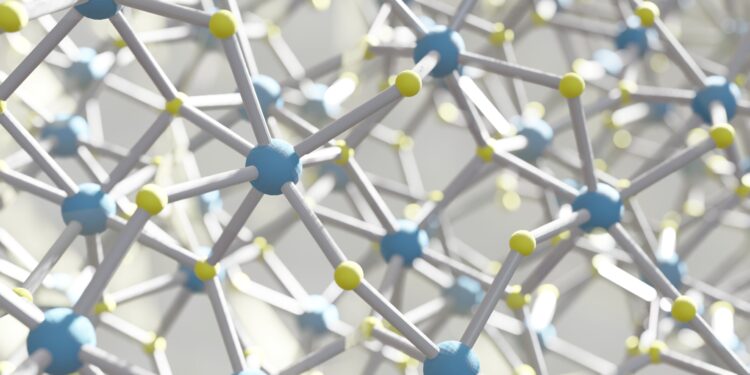In a specific crystalline phase, hafnium oxide, or hafnia, exhibits ferroelectric properties that scientists have been trying to exploit for years. University of Rochester theorists have helped take an important step toward making bulk ferroelectric and antiferroelectric hafnia available for use in a variety of applications, including high-performance computing. Credit: Illustration by the University of Rochester / Michael Osadciw
Scientists and engineers have been working for a decade to harness an elusive ferroelectric material called hafnium oxide, or hafnia, to usher in the next generation of computer memory. A team of researchers, including Sobhit Singh from the University of Rochester, published a study in the Proceedings of the National Academy of Sciences describing progress toward making bulk ferroelectric and antiferroelectric hafnia available for use in a variety of applications.
In a specific crystalline phase, hafnia exhibits ferroelectric properties, that is, an electrical polarization that can be changed in one direction or the other by applying an external electric field. This feature can be leveraged in data storage technology. When used in computing, ferroelectric memory has the advantage of being non-volatile, meaning it retains its values even when powered off, one of many advantages over most types of memory used today.
“Hafnia is a very interesting material because of its practical applications in computer technology, particularly for data storage,” says Singh, an assistant professor in the Department of Mechanical Engineering. “Currently, to store data we use magnetic forms of memory which are slow, require a lot of power to operate and are not very efficient. Ferroelectric forms of memory are robust, ultra-fast, cheaper to produce and more energy efficient.”
But Singh, who performs theoretical calculations to predict material properties at the quantum level, says bulk hafnia is not ferroelectric in its ground state. Until recently, scientists could only bring hafnia to its metastable ferroelectric state by subjecting it to a thin, two-dimensional layer of nanometer thickness.
In 2021, Singh was part of a team of Rutgers University scientists who allowed hafnia to remain in its metastable ferroelectric state by alloying the material with yttrium and rapidly cooling it. However, this approach had certain drawbacks. “It took a lot of yttrium to reach the desired metastable phase,” he says.
“So even though we achieved our goal, at the same time we hampered many key features of the material, because we were introducing a lot of impurities and disorder into the crystal. The question became: How can we achieve this? metastable state with as little yttrium as possible to improve the properties of the resulting material?”
In the new study, Singh calculated that by applying significant pressure, bulk hafnia could be stabilized in its metastable ferroelectric and antiferroelectric forms, both of which are of interest for practical applications in data and energy storage technologies. new generation.
A team led by Professor Janice Musfeldt of the University of Tennessee at Knoxville performed high-pressure experiments and demonstrated that at the expected pressure, the material transformed into the metastable phase and remained there even when the pressure was removed.
“This is a great example of experimental and theoretical collaboration,” says Musfeldt.
The new approach required only about half the amount of yttrium as a stabilizer, thereby significantly improving the quality and purity of the grown hafnia crystals. Now, Singh says he and other scientists will strive to use less and less yttrium until they find a way to mass produce ferroelectric hafnia for widespread use.
And as hafnia continues to attract increasing attention due to its fascinating ferroelectricity, Singh is hosting a discussion session on the material at the March 2024 meeting of the American Physical Society.
More information:
Musfeldt, JL et al, Structural phase purification of bulk HfO2:Y by pressure cycling, Proceedings of the National Academy of Sciences (2024). DOI: 10.1073/pnas.2312571121. doi.org/10.1073/pnas.2312571121
Provided by the University of Rochester
Quote: Manipulated Hafnia paves the way for next-generation memory devices (January 22, 2024) retrieved January 22, 2024 from
This document is subject to copyright. Apart from fair use for private study or research purposes, no part may be reproduced without written permission. The content is provided for information only.



